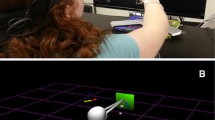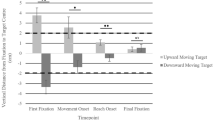Abstract
Participants executed right-handed reach-to-grasp movements toward horizontally translating targets. Visual feedback of the target when reaching, as well as the presence of additional cues placed above and below the target’s path, was manipulated. Comparison of average fixations at reach onset and at the time of the grasp suggested that participants accurately extrapolated the occluded target’s motion prior to reach onset, but not after the reach had been initiated, resulting in inaccurate grasp placements. Final gaze and grasp positions were more accurate when reaching for leftward moving targets, suggesting individuals use different grasp strategies when reaching for targets traveling away from the reaching hand. Additional cue presence appeared to impair participants’ ability to extrapolate the disappeared target’s motion, and caused grasps for occluded targets to be less accurate. Novel information is provided about the eye-hand strategies used when reaching for moving targets in unpredictable visual conditions.




Similar content being viewed by others
References
Ashida H (2004) Action-specific extrapolation of target motion in human visual system. Neuropsychologia 42:1515–1524. doi:10.1016/j.neuropsychologia.2004.03.003
Baker DH, Graf EW (2010) Contextual effects in speed perception may occur at an early age of processing. Vis Res 50:193–201. doi:10.1016/j.visres.2009.11.011
Battaglini L, Campana G, Casco C (2013) Illusory speed is retained in memory duration invisible motion. i-Perception 4:180–191. doi:10.1068/i0562a
Battaglini L, Contemori G, Maniglia M, Professor CC (2016) Fast moving texture has opposite effects on the perceived speed of visible and occluded object trajectories. Acta Psychol 170:206–214. doi:10.1016/j.actpsy.2016.08.007
Bekkering H, Sailer U (2002) Commentary: coordination of eye and hand in time and space. Prog Brain Res 140:363–373
Bennett SJ, Barnes GR (2003) Human ocular pursuit during the transient disappearance of a visual target. J Neurophysiol 90(4):2504–2520. doi:10.1152/jn.01145.2002
Bennett SJ, Barnes GR (2004) Predictive smooth ocular pursuit during the transient disappearance of a visual target. J Neurophysiol 92(1):578–590. doi:10.1152/jn.01188.2003
Bosco G Delle, Monache S, Gravano S, Indovina I, La Scaleia B, Maffei V, Zago M, Lacquaniti F (2015) Filling gaps in visual motion for target capture. Front Integr Neurosci. doi:10.3389/fnint.2015.00013
Brenner E, Smeets JBJ (2007) Flexibility in intercepting moving objects. J Vis 7:1–7. doi:10.1167/7.5.14
Brouwer A-M, Franz VH, Gegenfurtner KR (2009) Differences in fixations between grasping and viewing objects. J Vis 9(1):1–24. doi:10.1167/9.1.18
Bulloch MC, Prime SL, Marotta JJ (2015) Anticipatory gaze strategies when grasping moving objects. Exp Brain Res 233(12):3413–3423
Camors D, Jouffrais C, Cottereau BR, Durand JB (2015) Allocentric coding: spatial range and combination rules. Vis Res 109:87–98. doi:10.1016/j.visres.2015.02.018
Cavina-Pratesi C, Hesse C (2013) Why do the eyes prefer the index finger? Simultaneous recording of eye and hand movements during precision grasping. J Vis 13(5):1–15. doi:10.1167/13.5.15
Churchland MM, Chou I-H, Lisberger SG (2003) Evidence for object permanence in the smooth-pursuit eye movements of monkeys. J Neurophysiol 90(4):2205–2218. doi:10.1152/jn.01056.2002
Desanghere L, Marotta JJ (2011) “Graspability” of objects affects gaze patterns during perception and action tasks. Exp Brain Res 212(2):177–187. doi:10.1007/s00221-011-2716-x
Endo S, Wing AM, Bracewell RM (2011) Haptic and visual influences on grasp point selection. J Mot Behav 43(6):427–431. doi:10.1080/00222895.2011.621996
Erlikhman G, Caplovitz GP (2016) Decoding information about dynamically occluded objects in visual cortex. Neuroimage. doi:10.1016/j.neuroimage.2016.09.024
Fiehler K, Wolf C, Klinghammer M, Blohm G (2014) Integration of egocentric and allocentric information during memory-guided reaching to images of a natural environment. Front Hum Neurosci 8:1–12. doi:10.3389/fnhum.2014.00636
Flombaum JI, Scholl BJ, Pylyshyn ZW (2008) Attentional resources in visual tracking through occlusion: the high-beams effect. Cognition 107:904–931. doi:10.1016/j.cognition.2007.12.015
Foulsham T, Gray A, Nasiopoulos E, Kingstone A (2013) Leftward biases in picture scanning and line bisection: a gaze-contingent window study. Vis Res 78:14–25. doi:10.1016/j.visres.2012.12.001
Jewell G, McCourt ME (2000) Pseudoneglect: a review and meta-analysis of performance factors in line bisection tasks. Neuropsychologia 38:93–110
Klinghammer M, Shütz I, Blohm G, Fiehler K (2016) Allocentric information is used for memory-guided reaching in depth: a virtual reality study. Vis Res 129:13–24. doi:10.1016/j.visres.2016.10.004
Lee D, Port NL, Georgopoulos AP (1997) Manual interception of moving targets II. On-line control of overlapping submovements. Exp Brain Res 116:421–433
Makin ADJ, Chauhan T (2014) Memory-guided tracking through physical space and feature space. J Vis 14:1–15. doi:10.1167/14.13.10
Makin ADJ, Poliakoff E (2011) Do common systems control eye movements and motion extrapolation? Q J Exp Psychol 64:1327–1343
Mrotek LA, Soechting JF (2007) Predicting curvilinear target motion through an occlusion. Exp Brain Res 178:99–114. doi:10.1007/s00221-006-0717-y
Neely K, Heath M, Binsted G (2008a) Egocentric and allocentric visual cues influence the specification of movement distance and direction. J Mot Behav 40(3):203–213
Neely KA, Tessmer A, Binsted G, Heath M (2008b) Goal-directed reaching: movement strategies influence the weighting of allocentric and egocentric visual cues. Exp Brain Res 186(3):375–384
Salvucci DD, Goldberg JH (2000) Identifying fixations and saccades in eye-tracking protocols. In: Proceedings of the eye tracking research and applications symposium. ACM Press, New York, pp 71–78
Scholl BJ, Pylyshyn ZW (1999) Tracking multiple items through occlusion: clues to visual objecthood. Cogn Psychol 38(2):259–290. doi:10.1006/cogp.1998.0698
Soechting J, Flanders M (2008) Extrapolation of visual motion for manual interception. J Neurophysiol 99(2956):2967. doi:10.1152/jn.90308.2008
Teixeira LA, Chua R, Nagelkerke P, Franks IM (2006) Use of visual information in the correction of interceptive actions. Exp Brain Res 175:758–763. doi:10.1007/s00221-006-0740-z
Terao M, Murakami I, Nishida S (2015) Enhancement of motion perception in the direction opposite to smooth pursuit eye movement. J Vis 15(13):2. doi:10.1167/15.13.2
Verheij R, Brenner E, Smeets JBJ (2014) The influence of target object shape on maximum grip aperture in human grasping movements. Exp Brain Res 232:3569–3578
Voudouris D, Smeets JBJ, Brenner E (2016) Fixation biases toward the index finger in almost-natural grasping. PLoS One. doi:10.1371/journal.pone.0146864
Whitwell RL, Ganel T, Byrne CM, Goodale MA (2015) Real-time vision, tactile cues, and visual form agnosia: Removing haptic feedback from a “natural” grasping task induces pantomime-like grasps. Front Hum Neurosci. doi:10.3389/fnhum.2015.00216
Acknowledgements
This research was supported by a grant from the Natural Science and Engineering Research Council of Canada (NSERC) held by J.J.M.
Author information
Authors and Affiliations
Corresponding author
Ethics declarations
Ethical standards
All procedures performed in studies involving human participants were in accordance with the ethical standards of the institutional and/or national research committee and with the 1964 Helsinki declaration and its later amendments or comparable ethical standards.
Conflict of interest
The authors declare that they have no conflict of interest.
Rights and permissions
About this article
Cite this article
Langridge, R.W., Marotta, J.J. Grasping occluded targets: investigating the influence of target visibility, allocentric cue presence, and direction of motion on gaze and grasp accuracy. Exp Brain Res 235, 2705–2716 (2017). https://doi.org/10.1007/s00221-017-5004-6
Received:
Accepted:
Published:
Issue Date:
DOI: https://doi.org/10.1007/s00221-017-5004-6




